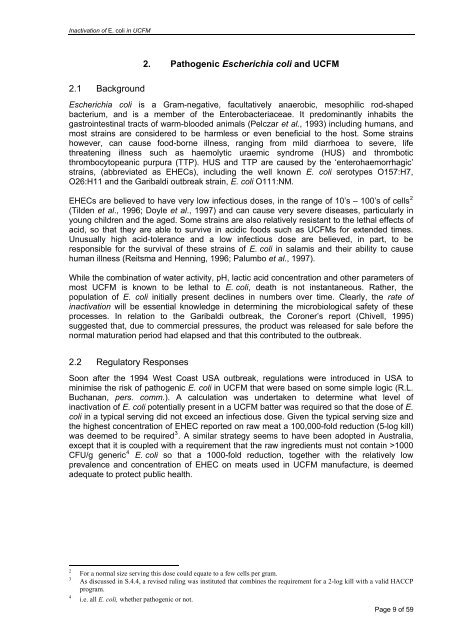Download "Predicting E. coli inactivation in uncooked comminuted ...
Download "Predicting E. coli inactivation in uncooked comminuted ...
Download "Predicting E. coli inactivation in uncooked comminuted ...
You also want an ePaper? Increase the reach of your titles
YUMPU automatically turns print PDFs into web optimized ePapers that Google loves.
Inactivation of E. <strong>coli</strong> <strong>in</strong> UCFM2.1 Background2. Pathogenic Escherichia <strong>coli</strong> and UCFMEscherichia <strong>coli</strong> is a Gram-negative, facultatively anaerobic, mesophilic rod-shapedbacterium, and is a member of the Enterobacteriaceae. It predom<strong>in</strong>antly <strong>in</strong>habits thegastro<strong>in</strong>test<strong>in</strong>al tracts of warm-blooded animals (Pelczar et al., 1993) <strong>in</strong>clud<strong>in</strong>g humans, andmost stra<strong>in</strong>s are considered to be harmless or even beneficial to the host. Some stra<strong>in</strong>showever, can cause food-borne illness, rang<strong>in</strong>g from mild diarrhoea to severe, lifethreaten<strong>in</strong>g illness such as haemolytic uraemic syndrome (HUS) and thromboticthrombocytopeanic purpura (TTP). HUS and TTP are caused by the ‘enterohaemorrhagic’stra<strong>in</strong>s, (abbreviated as EHECs), <strong>in</strong>clud<strong>in</strong>g the well known E. <strong>coli</strong> serotypes O157:H7,O26:H11 and the Garibaldi outbreak stra<strong>in</strong>, E. <strong>coli</strong> O111:NM.EHECs are believed to have very low <strong>in</strong>fectious doses, <strong>in</strong> the range of 10’s – 100’s of cells 2(Tilden et al., 1996; Doyle et al., 1997) and can cause very severe diseases, particularly <strong>in</strong>young children and the aged. Some stra<strong>in</strong>s are also relatively resistant to the lethal effects ofacid, so that they are able to survive <strong>in</strong> acidic foods such as UCFMs for extended times.Unusually high acid-tolerance and a low <strong>in</strong>fectious dose are believed, <strong>in</strong> part, to beresponsible for the survival of these stra<strong>in</strong>s of E. <strong>coli</strong> <strong>in</strong> salamis and their ability to causehuman illness (Reitsma and Henn<strong>in</strong>g, 1996; Palumbo et al., 1997).While the comb<strong>in</strong>ation of water activity, pH, lactic acid concentration and other parameters ofmost UCFM is known to be lethal to E. <strong>coli</strong>, death is not <strong>in</strong>stantaneous. Rather, thepopulation of E. <strong>coli</strong> <strong>in</strong>itially present decl<strong>in</strong>es <strong>in</strong> numbers over time. Clearly, the rate of<strong><strong>in</strong>activation</strong> will be essential knowledge <strong>in</strong> determ<strong>in</strong><strong>in</strong>g the microbiological safety of theseprocesses. In relation to the Garibaldi outbreak, the Coroner’s report (Chivell, 1995)suggested that, due to commercial pressures, the product was released for sale before thenormal maturation period had elapsed and that this contributed to the outbreak.2.2 Regulatory ResponsesSoon after the 1994 West Coast USA outbreak, regulations were <strong>in</strong>troduced <strong>in</strong> USA tom<strong>in</strong>imise the risk of pathogenic E. <strong>coli</strong> <strong>in</strong> UCFM that were based on some simple logic (R.L.Buchanan, pers. comm.). A calculation was undertaken to determ<strong>in</strong>e what level of<strong><strong>in</strong>activation</strong> of E. <strong>coli</strong> potentially present <strong>in</strong> a UCFM batter was required so that the dose of E.<strong>coli</strong> <strong>in</strong> a typical serv<strong>in</strong>g did not exceed an <strong>in</strong>fectious dose. Given the typical serv<strong>in</strong>g size andthe highest concentration of EHEC reported on raw meat a 100,000-fold reduction (5-log kill)was deemed to be required 3 . A similar strategy seems to have been adopted <strong>in</strong> Australia,except that it is coupled with a requirement that the raw <strong>in</strong>gredients must not conta<strong>in</strong> >1000CFU/g generic 4 E. <strong>coli</strong> so that a 1000-fold reduction, together with the relatively lowprevalence and concentration of EHEC on meats used <strong>in</strong> UCFM manufacture, is deemedadequate to protect public health.234For a normal size serv<strong>in</strong>g this dose could equate to a few cells per gram.As discussed <strong>in</strong> S.4.4, a revised rul<strong>in</strong>g was <strong>in</strong>stituted that comb<strong>in</strong>es the requirement for a 2-log kill with a valid HACCPprogram.i.e. all E. <strong>coli</strong>, whether pathogenic or not.Page 9 of 59


